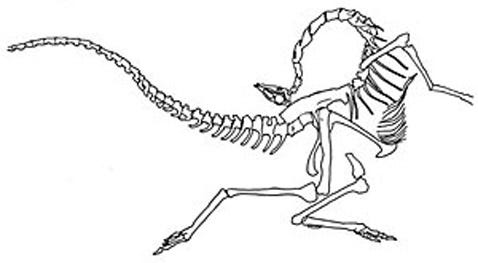If you’ve looked at the articulated 150-million-year-old Archaeopteryx fossils, you probably have noticed that they all have a weirdly similar pose: their heads are thrown over their backs, mouths open and tail curved upwards. Scientists have been puzzled for years by what caused this distinctive pose, but now two paleontologists propose an explanation: this characteristic posture was the result of agonized death throes triggered by brain damage and suffocation.
If you’ve looked at the articulated 150-million-year-old Archaeopteryxfossils, you probably have noticed that they all have a weirdly similar pose; their heads are thrown over their backs, mouths open and tail curved upwards. Scientists have been puzzled for years by what caused this distinctive pose, but now two paleontologists propose an explanation: this characteristic posture was the result of agonized death throes triggered by brain damage and suffocation.
This position is not unusual for intact fossils; many dinosaurs and their relatives, as well as many early mammals, exhibit this classic head-back pose. The usual explanation provided by paleontologists is either that the animals died in water and the currents drifted the bones into that position, or that rigor mortis or drying muscles, tendons and ligaments contorted the limbs.
“I’m reading this in the literature and thinking, “This doesn’t make any sense to me as a veterinarian,’” said Cynthia Marshall Faux (pronounced “fox”), lead author on a paper recently published in the quarterly journal Paleobiology. Faux is a veterinarian-turned-paleontologist who also is a curatorial affiliate with Yale University’s Peabody Museum.
“Paleontologists aren’t around sick and dying animals the way a veterinarian is, where you see this posture all the time in disease processes, in strychnine cases, in animals hit by a car or in some sort of extremis.”
Instead, Faux and her co-author, Kevin Padian who is professor of integrative biology and curator in the Museum of Paleontology at the University of California, Berkeley, argue that dinosaurs and birds died with this posture because of damage to their central nervous systems.
This is because the head-back death pose is well known as opisthotonus and is the result of damage to the cerebellum. In humans and animals, cerebellar damage can result from suffocation, meningitis, tetanus or poisoning, and often accompanies a long, slow death. Basically, the cerebellum is a brain region that controls fine muscle movement, which includes the body’s antigravity muscles that keep the head upright. When the cerebellum ceases to function, the antigravity muscles pull at full force, tipping the head and tail back, contracting the limbs and opening the mouth.
It is likely that at least some animals fossilized in this posture suffocated in an ash fall during a volcanic eruption — consistent with the fact that many fossils are found in ash deposits, Faux and Padian noted. But other sources of brain damage also exist, including disease, brain trauma, severe bleeding, thiamine deficiency or poisoning.
Tested this hypothesis, Faux watched the progression of body movements made by dead animals.
“In horses and smaller animals, rigor mortis sets in within a couple of hours, so I just looked to see if they were moving or not,” Faux noted. “And they weren’t moving. They were staying in whatever position I’d left them in. I thought, ‘If birds aren’t doing it, and I’d never observed a horse doing it, then why would dinosaurs be doing it?’”
To further test whether muscles or tendons contracted asymmetrically and give rise to this head-back position, Faux conducted an experiment with two euthanized red-tailed hawks, which she dried for two months in styrofoam peanuts. She found that most joints have counterbalancing muscles that dry in the opposite direction, so there was no reason to expect that muscles could pull at a joint asymmetrically during drying. She also tested tendon drying by pinning out beef tendons as they dried. She found that even though they shrank somewhat, they did not shrink enough to dislodge the pins.
Further, all opisthotonic dinosaurs are very well preserved, so their bodies did not sit out in the open for long, exposed to scavengers that would have quickly scattered their bones. In that case, Padian wondered, how could they have been exposed long enough to dry out?

The authors also mentioned a particular fossil Allosaurus that suffered bone lesions suggestive of a bacterial infection that also can cause meningitis, a disease that can produce opithotonus. The authors point out that their explanation of the opisthotonic posture in dinosaurs and other animals provides a way to assess the role played by microbes in evolution, whether through disease or through other processes such as algal blooms — so-called “red tides” — that can suffocate aquatic animals.
These observations “suggest that reevaluation may be in order for an untold number of paleoenvironments whose story has been at least partly explained on the basis of the death positions of many of their fossil vertebrates,” the authors concluded in their Paleobiology paper.
Sources:
Faux, C.M., and Padian, K. (2007). The opisthotonic posture of vertebrate skeletons: postmortem contraction or death throes? Paleobiology 33(2), 201–226 | doi:10.1666/06015.1
Originally published at scienceblogs.com on 7 June 2007.
